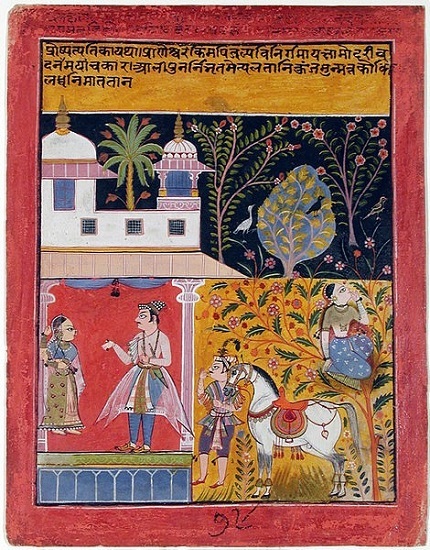Nayaka–Nayika Bheda
Introduction
The Natyashastra, written by Bharat Muni, who is known for dealing mostly with dance theatre or natya, and whose work dates back to almost the first century B.C., is the primary source of the nayika.
Bharata Muni provided the groundwork for the literary tradition that has been carried on by his ancestors in a well-defined manner of examining and categorising the feelings that men and women in love experience, who are referred to as nayaka and nayika. In actuality, a surprising number more were found in the later writings. And regardless of whether one reads the Natyashastra or the Kavyasastras, it is noteworthy that nayika was a purely male perspective that was only discussed by men.

English: thesandiegomuseumofartcollection, Nayaka-Nayika Bheda (6125094114), marked as public domain, more details on Wikimedia Commons
History
Numerous categorizations of Nayika were made possible by the substantial volume of canonical literature that discussed her. Also provided by Bharata was "a delicate classification of women according to their mood, sentiment, and the situation called Nayika-bheda."
The Natyashastra lists a total of 384 different varieties of nayika and 144 different forms of nayaka.
Bhanu Misra's Rasamanjari, a study that sought to reconcile all of the current nayika typologies, also identified 384 potential nayika types.
In contrast, "nayika-bheda came to 128 varieties of heroines with permutations and combinations." Later, the number of nayika was reduced to eight, and this character took up a lot more room in dramatic and erotic literature than the hero or nayaka.
In Jayadeva's Gita Govinda, Radha and Krishna are praised for their ardour and love; Radha is the nayika and Krishna is the nayak. Each psychological state of nayika in the portion of Jayadeva that describes the heroine's eight moods can be recognised by reference to its scientific name or distinguishing sign or symbol.
What is Nayika Bheda?
The Natya Shastra, Bharata's Sanskrit treatise on performing arts, classifies eight different varieties of nayika under the umbrella term Ashta-Nayika. The eight nayika stand in for eight various states (avastha) regarding her nayaka. It has been a motif in Indian painting, literature, sculpture, and classical dance as one of the archetypal states of the amorous heroine.
Vasakasajja (One is decorated for union) –Here, Nayika is anticipating the arrival of her hero after a long voyage.
Virahonkhanditha (One distressed by the separation) –The Nayika longs for her beloved, who hasn't returned to her yet. She is utterly distraught about her lover's continued absence from his voyage. She expresses her anguish openly and finds it difficult to tolerate joy till her beloved comes back. She is never alone with her tears.
Svadhinabhartruka (One who is pleased with her lord) –Her lover is highly devoted to this Nayika. Everything around her makes her happy. She enjoys going places and having fun. She is generally happy with how her life is turning out.
Kalahantharitha (One who confesses post fight) –This Nayika had argued with her partner and is now feeling regret about it as she is no longer with him. She rejected her sweetheart out of sudden rage and haughtiness, a decision she now regrets greatly. She tends to be agitated.
Khanditha (One who has a grudge against her beloved) –This Nayika is upset and furious with her beloved for being unfaithful. She treats him with a lot of disrespect.
Vipralabdha (One who thinks her partner has betrayed her) -The Nayika is unhappy, irate, swooning, sad, and other such emotions because she feels deceived.
Proshitabhartruka (Onewho yearns for her sweetheart) –The Nayika is upset about their brief separation since she misses her beau who has left on vacation.
Abhisarika (One who searches for her sweetheart) –The Nayika in this story is quite courageous and has no reluctance in seeking out her sweetheart. She never stops pursuing her beloved. She is perceptive, brave, and carefree.
Which Rasa is related to the meeting of Nayak and Nayika?
The wife who commands her husband and is loved by him is known as Svadhinabhartruka ("one having her husband in subjugation") or Svadhinapatika (as termed by Keshavadasa).
Her passionate affection and appealing charms enslave him. He is loyal and committed to her. This nayika is portrayed in paintings with a nayaka who places vermilion tilak (mark) on her forehead or mahawar on her feet.
Radha is represented as a Svadhinabhartruka in Kuru Yadunandana and Jayadeva's Gita Govinda.
Svadhinabhartruka is linked to numerous raginis, including Malashri, Travanika, Ramakriti, Jaitashri, and Purvi.
The Nine Rasas discussed in Indian Scriptures
The nine rasas are discussed in Indian scriptures −
Rati (Love)
Hasa (Humour)
Ṡōka (Sorrow)
Krōdha (Anger)
Utsāha (Energy)
Bhaya (Fear)
Juguptsa (Disgust)
Vismaya (Wonder)
Vairāgya/Ṡama/ Nirvēda (Detachment)
Conclusion
"Nayaka-Nayika bheda," describes many classifications of heroes and heroines based on their distinctive qualities, physical traits, social standing, state of mind, or behaviour in romantic relationships, among other factors. The limited scope of Nayika Bheda's exploration of the affectionate side of women's nature for a man-woman relationship situation in Natya Shastra and related texts on dramaturgy-poetics as applied in Indian classical dance.
FAQs
Q1. What are the 3 styles of Bharatanatyam?
Ans. The Melattur, Pandanallur, and Vazhuvoor forms are the three fundamental forms in Bharatanatyam. It is one of the classical dances of India which originated in Tamil Nadu. It is done by a female dancer.
Q2. What are the 8 classical dances?
Ans. There are between eight classical dances, depending on the source and expert. The eight dance styles recognised by the Sangeet Natak Academy are Bharatanatyam, Kathak, Kuchipudi, Odissi, Kathakali, Sattriya, Manipuri, and Mohiniyattam.
Q3. Where can we see the depiction of Astha-Nayika in Indian culture?
Ans. Indian classical dance forms like Kathak and literature, as well as sculpture and painting, have all used the Ashta-Nayika as inspiration.
